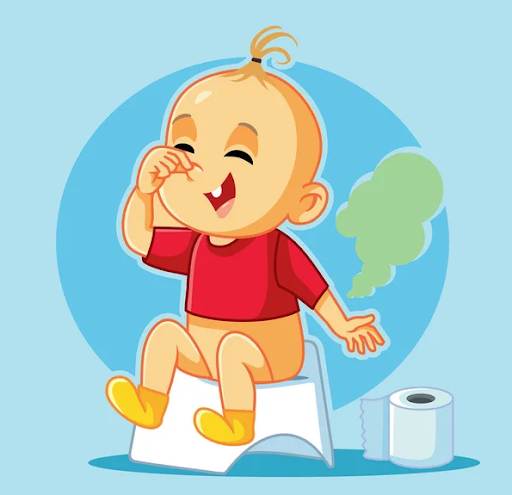 Green poop in children is not a cause for concern unless it becomes persistent. Bile is usually the reason for green poop in your child. Produced by the liver, bile is a brownish-green colored liquid that catalyzes the digestive process. Green poop is usually caused by too much bile in the stool, and is commonly associated with diarrhea. In diarrhea, the food moves too quickly through the GI tract, not giving bile enough time to break everything down. The poop may have solids in it as well as food that may not have been digested fully. Green stool, which is more common in formula-fed babies than in breastfed infants, can also be caused by excess iron ingestion from supplements.
Green poop in children is not a cause for concern unless it becomes persistent. Bile is usually the reason for green poop in your child. Produced by the liver, bile is a brownish-green colored liquid that catalyzes the digestive process. Green poop is usually caused by too much bile in the stool, and is commonly associated with diarrhea. In diarrhea, the food moves too quickly through the GI tract, not giving bile enough time to break everything down. The poop may have solids in it as well as food that may not have been digested fully. Green stool, which is more common in formula-fed babies than in breastfed infants, can also be caused by excess iron ingestion from supplements.
Occasional green poop is normal, but if the unusual color lasts for more than 5 days, there may be some other underlying problem with your child’s GI tract.
Red, black or white stools are more serious and require immediate intervention. Contact your healthcare provider if you see red, black, or white stool in your child’s diaper or in the toilet. Dark green stool can appear black but isn’t likely serious.
Green Poop & Diarrhea

Infants or children with diarrhea typically produce stool the color of whatever they have recently eaten. For example, if your kid ate blue Jell-O and then had diarrhea, the toilet or diaper contents will likely be blue.
Babies with diarrhea are more likely to be dehydrated. Dehydration is a threat to little ones, so make sure that they are getting plenty of fluids.
It’s important not to impose dietary restrictions on your baby without first consulting your pediatric healthcare provider. Babies require appropriate nutrition for healthy growth. Limiting their food intake because you think they’re gaining too much weight, is a mistake. Every child needs access to a plentiful, healthy, and balanced diet.
Constipation in Babies
Breastfed babies typically have looser stools than formula-fed babies. Constipation is rare in breastfed babies. Constipated babies have small, pellet-like poop that is difficult to pass.
Meconium and Babies
Meconium is your baby’s first poop after being born and sometimes before that. It is thick and black in color and is not harmful to your baby even if ingested before birth. The normal span for meconium is a few days, but if the black poop occurs for over a week, consult your holistic pediatrician.
Probiotics for Green Poop
For persisting green-poop-problems that aren’t serious, try probiotics. Breastfeeding moms and babies should take probiotics to help boost a community of beneficial bacterial flora in the GI tract. We recommend finding a probiotic with Bifida factor and acidophilus. A well-nourished community of gut bacteria makes all the difference in your baby’s digestion!
The Poop Rainbow

Black Poop
Black poop is considered a serious problem as this could indicate that part of the upper GI tract is bleeding. Possible dietary causes for black poop may include iron supplements, black licorice, and others. Since breastfeeding can sometimes cause cracked and bleeding nipples in mothers, black flecks in a breastfed baby’s poop may simply be blood from the mother. Dark green stool can sometimes be confused for black, so get your flashlight out.
White Poop
Chalky white poop is also serious. This means that your baby is not producing enough bile and has some issue in the liver or gallbladder. Bile is what turns poop brown, so white poop could mean that your baby isn’t producing bile or there is a bile duct obstruction. Possible causes for white poop are Bismuth Subsalicylate or other anti-diarrheal drugs.
Bright Red Poop
Bright red or raspberry-colored poop that looks like mucus (similar to congealed fat) could be evidence of a serious intestinal problem. It indicates bleeding in the lower intestinal tract. Possible dietary causes for it may include ingesting red food color, cranberries, tomato ketchup or juice. Contact your pediatrician and collect a sample for the lab.
Dark Red Poop
- If the poop appears normal with specks of dark red, this is typically caused by a milk allergy.
- If the red color in the poop is more persistent, it may indicate lower intestinal bleeding due to ulcer or infection.
- Dark red poop in hard pellets may indicate that your baby is constipated. The red is blood (streaked or spotted throughout) and is likely due to small tears in the rectum. Add a little bit of prune juice (1 teaspoon for newborns, 1 tablespoon for babies) to the next bottle of milk to soften things up.
- Watery poop that is streaked with dark red is also a sign of a bacterial infection.
In all the cases listed above, you should immediately consult your pediatrician.
Dark Green Poop
Dark green poop results from excess iron floating through your baby’s digestive system. The iron usually creates thick, constipated stools. Don’t stop giving your baby iron if your practitioner has prescribed iron supplementation. Iron is necessary for brain growth and development and green stool is worth the benefits of iron.
However, some dark green stool can also be a sign of a protein allergy, likely due to milk.
Light Green Poop
Light green or lime green poop, accompanied by a frothy, bubbly texture, is indicative of an imbalance in the foremilk and hindmilk from breastfeeding. Foremilk is characterized as thin and sweet and is drawn from the breasts in the start of the suckling process. Hindmilk is thicker and contains more fat as well as most of the nutrients your baby needs for normal growth. Lime green means that the baby is snacking too much on the sweet foremilk. Keep your baby on the breast longer so that they can pull out the hindmilk. Another way to determine the right balance is by weight gain. Babies who are getting hindmilk will gain weight faster than babies snacking more on the foremilk.
If you are breastfeeding for at least 20 minutes per breast and the problem persists, lime green colored poop can be a sign of a viral infection. Save some of the stool for testing and contact your pediatric healthcare provider.
Pink Poop
Rosey pink poop is usually harmless and due to something your baby has eaten (i.e. beets, cranberries, tomatoes, fruit loops, cherry popsicles, etc.).
Light Brown Poop
Light brown poop that looks like hummus is normal for formula-fed babies. Thick poop that seems more like peanut butter could mean that your baby is constipated. If the “hummus” poop has a greenish tinge like guacamole, this is normal, especially if you’ve started feeding solid foods to your baby.
Dark Brown Poop
90% of all diaper changes will be dirt-brown. This is a good sign that your baby’s microbes are functioning properly, especially after you’ve introduced solid food to your baby’s diet.
Yellow Poop
Mustard yellow is the most common poop color for breastfed babies and is totally normal. In addition, partially digested milk solids are also normal and appear as little yellow-white seeds in the poop.
When to Contact your Pediatric Provider
Here are some of the instances where you should contact your pediatrician immediately:
- Blood or mucus in the poop
- Fever
- Vomiting
- Refusal to eat
- Signs of dehydration (Decreased or dark-colored urine, not producing tears, sunken fontanelle)
- Decreased activity
Finally, respond to this blog or contact us with questions or comments!







